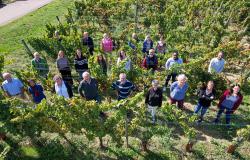Biodiversity Reading time 4 min
COP15 on biological diversity: INRAE’s contributions
Published on 29 November 2022
INRAE, an observer member to the Convention on biological diversity meetings
From genes to species to ecosystems, INRAE is interested in all facets of biodiversity. The conservation of genetic resources; the contribution of biodiversity to system resilience and sustainability; the relationship between landscape dynamics and biogeochemical cycles; and the adaptive management of ecosystems —these issues are all central to INRAE's research, which combines observation, experimentation, and modelling at different spatial and temporal scales with a diversity of socio-economic and biotechnical approaches.
As a world leading research organisation specialising in agriculture, food and environment, INRAE’s goal is to be a key player in the transitions necessary to address major global challenges, including biodiversity, climate change and desertification. In its 2030 vision document, “Responding to environmental challenges and their associated risks” is the first scientific priority of the Institute. INRAE has an interdisciplinary research program on biodiversity and ecosystem services.
As of 2022, INRAE is an observer to the meetings of the 15th Conference of the Parties to the Convention on Biological Diversity (COP15). The institute is represented by Jean-François Soussana, Vice-President of international Policy and Thierry Caquet, Environment Scientific Director of the Institute.
Spanning 50 years of historical contributions to environmental governance
1979
Signature in Geneva of the Convention on Long-Range Transboundary Air Pollution, INRAE’s experts have contributed to its implementation.
2012
INRAE is a member of the Intergovernmental Science-Policy Platform on Biodiversity and Ecosystem Services (IPBES), also called as the IPCC of biodiversity, since 2012. The Institute supported IPBES through its participation in the French multi-agency group led by the French Foundation for Biodiversity Research, set up in 2008. INRAE’s researchers participate in some of the IPBES reports, such as the regional assessment of biodiversity and ecosystem services focused on continental Europe.
January 2021
PREZODE international initiative was launched at the One planet Summit in January 2021, at the initiative of INRAE, IRD and CIRAD. Nearly 170 partners, including 15 governments, now support the initiative. It places research on animal, human and environmental health at the heart of the global efforts needed to better understand, prevent, monitor, and detect early zoonotic pandemic risks.
September 2021
INRAE became an observer member of IUCN in January 2021 and presented a joint scientific contribution with IRD and CIRAD at the IUCN World Conservation Congress “Growing biodiversity together”.
June 2022
INRAE and its partners presented the key messages for sustainable transitions in the land sector, for biodiversity and climate, at the Stockholm +50 international Conference.
Research calls for the protection of genetic diversity
Genetic diversity is the basis of all biodiversity, allowing species and populations to adapt to changing environmental conditions and build their resilience.
For 3 years, Myriam Heuertz, researcher at the Joint Reserch Unit Biodiversity Gene Community (UMR Biogeco) of the INRAE Nouvelle Aquitaine-Bordeaux Research Center, has participated, through the COST G-BIKE action and the Coalition for Conservation Genetics, in an international communication strategy to include the protection of genetic diversity within species in the Global Biodiversity Framework, to be adopted at COP15.
The group of researchers has organized a number of webinars for the delegations of the 196 parties to the CBD of COP15, including 2 in November 2022. The objective is to inform delegations about genetic diversity and to make concrete suggestions for its protection in the Global Biodiversity Framework, based on validated scientific knowledge.
Three indicators of genetic diversity have thus been proposed in 2020 :
- The number of populations with an effective genetic size greater than 500;
- The number of populations maintained, not extinct in the post-industrial era;
- The number of species and populations monitored with DNA-based tools.
These indicators help monitor the conservation status of genetic diversity in relation to the objectives of the global biodiversity framework. The first 2 indicators do not require the use of DNA data, facilitating their use in all countries. Their applicability has been demonstrated in 9 countries in a scientific paper currently being published on “proxy” databases, such as population census or distribution areas.
No less than 14 scientific papers have been published or submitted in international scientific journals on the importance and feasibility of protecting genetic diversity within the global biodiversity framework, many of them co-authored INRAE. To facilitate this process at the CBD and in state public policies, 4 policy briefs translated into several languages have been published.
A side-event will be organized at COP15 to continue to inform and raise awareness on the importance of including genetic diversity in the future global framework.
Research excellence for biodiversity
Biodiversity is at the heart of our research. INRAE's scientists work with local stakeholders to co-design and implement nature-based solutions and to devise ways to halt the erosion of biodiversity and encourage its recovery. Discover our work on biodiversity with our interactive press report.
In 2022, INRAE produced two collective scientific expert reports on biodiversity and its ecosystem services, in support of public policies, to reduce the use of pesticides in crops.
- The first, produced with IFREMER, assesses the impacts of plant protection products on biodiversity and ecosystem services. Results of the expertise.
- The second, led by INRAE, focuses on solutions, demonstrating the benefits of plant diversity for crop protection. Read the conclusions.
INRAE teams contribute to the production of excellent research on biodiversity. Three exceptional portraits and journeys:

An ardent observer of nature, fruit-tree specialist and plant virome pioneer, Thierry Candresse is an internationally recognised virologist.

Didier Azam is the director of the INRAE U3E Experimental Unit for Aquatic Ecology and Ecotoxicology, he developped an ambitious project for experimental facilities aimed at furthering knowledge of aquatic environments.

INRAE’s “grapevine resistance” team is identifying naturally disease-resistant grapes, a work that led to the official registration of nine grape varieties that are resistant to both downy and powdery mildew.
